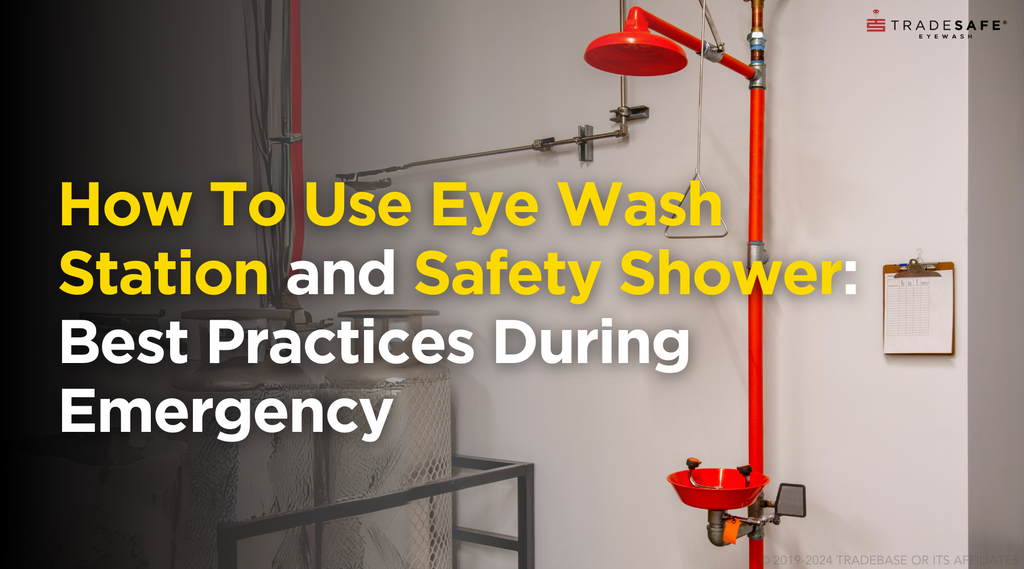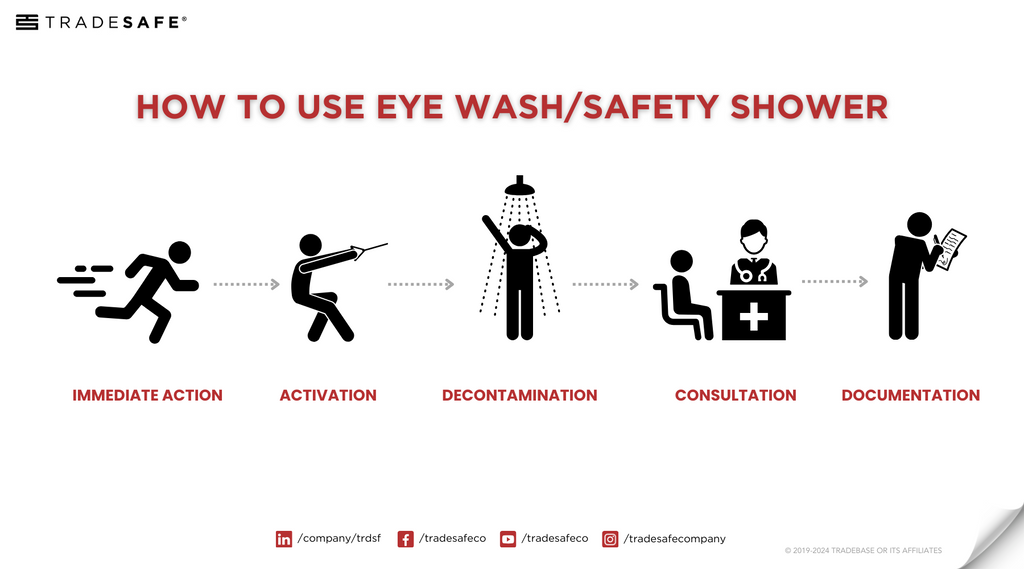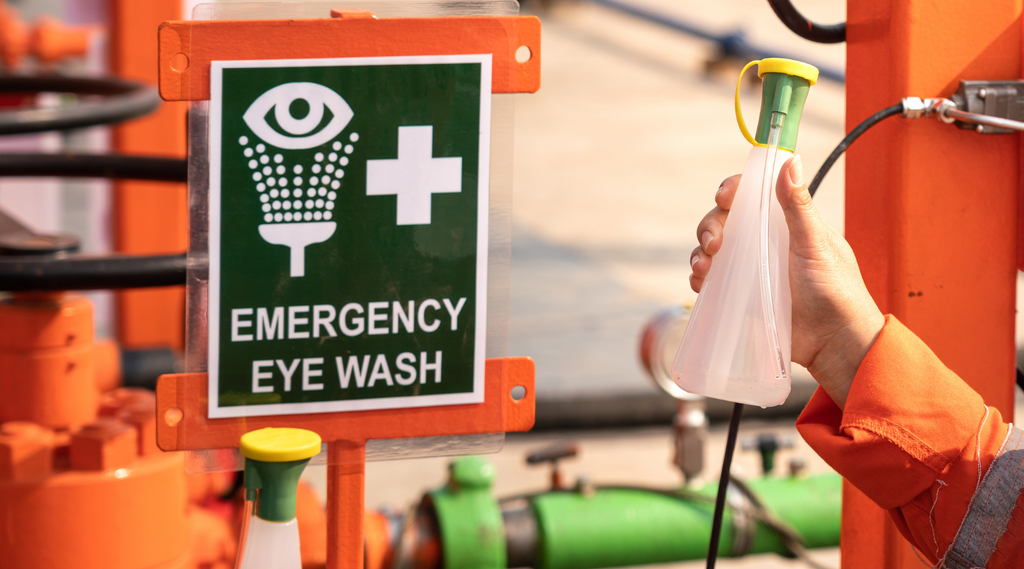
Eye wash stations and safety showers are essential in workplaces dealing with chemicals or hazardous substances. They provide immediate relief in accidents, such as chemical splashes, by flushing harmful materials from the body, particularly from sensitive areas like the eyes and skin. Quick access to these facilities can prevent serious injuries or lessen the severity of chemical burns, making them crucial for workplace safety.
Proper operation of eye wash stations and safety showers is crucial to ensure effective flushing and decontamination. Thorough rinsing removes substances from affected areas, reducing prolonged damage, while incorrect use can lead to inadequate decontamination or additional injuries. Therefore, understanding how to use eye wash station and emergency shower correctly is fundamental to maintaining safety in hazardous work environments.
Using Eye Wash Stations In Emergencies

An eye wash station is a crucial safety device designed specifically for rinsing the eyes in case they are exposed to hazardous substances. Its main purpose is to provide immediate decontamination to the eyes, diluting and flushing out chemicals or particles that can cause injury or infection. This rapid response is vital to minimize damage to the eyes, which are particularly vulnerable during chemical exposures.
For an eye wash station to be effective in emergencies, it must meet OSHA regulations, in accordance with the ANSI Z358.1 standard. Here’s a brief overview of the key requirements for eye wash stations in facilities.
- Accessibility: The location of the eyewash station must be easy to reach, ideally within 10 seconds of the hazard area, and should not have any obstacles in the way that could delay treatment.
- Proper Installation: Eye wash stations should be installed at a height suitable for use without requiring the person to stoop or kneel. They must be clearly marked and well-lit.
- Adequate Flow: It should provide a controlled flow of flushing fluid, typically tepid water, at a low pressure to avoid further injury to the eyes.
- Maintenance: Regular maintenance checks are required to ensure the eye wash station is operational when needed, including checking for cleanliness and proper fluid levels.
How To Use Eye Wash Station
When a hazardous incident concerning the eye occurs, knowing how to use eye wash station effectively can be critical. With this in mind, here is a detailed guide on how to manage emergency situations - from the moment of exposure to post-injury medical care.
1. Immediate Action
Upon exposure, immediately stop what you are doing and quickly move to the nearest eye wash station. Delays can lead to more severe injuries. Ensure that the path to the eye wash station is always clear to prevent delays during emergencies.
2. Eye Wash Station Activation
As an employee, it is your duty to familiarize yourself with emergency response protocols, tools, and equipment. For eye wash stations, it is critical to know how the unit works based on the type of activation mechanism. Doing so helps avoid confusion in times of emergencies. Once you’ve located the emergency eye wash area, activate the unit to start the flushing process.
3. Proper Flushing Technique
To flush the eyes effectively, place yourself in front of the nozzles until the water is gently reaching your face. Use two fingers, typically the thumb and forefingers, to hold your eyelids open. Continuously flush your eyes for at least 15 minutes, as required by OSHA standards. In case of exposure to a harsher chemical or substance, flush the eyes for longer. Aside from maintaining contact with the water for at least 15 minutes, move your eyes in all directions to allow the fluid to reach other parts and ensure maximum flush.
4. Consult Safety Data Sheet (SDS)
Once the suggested 15-minute flush is complete, consult the workplace’s safety data sheet to quickly identify the chemical or substance involved. This step will provide you with vital information on the substance’s chemical properties and a better idea of the severity of the case. Follow any specific first aid measures recommended in the SDS that pertain to eye exposure.
5. Seek Medical Attention
Eye wash stations are only first-aid emergency response equipment that should not be used in place of professional medical care. Even if symptoms seem mild, some chemicals can cause delayed reactions. A healthcare professional can assess the extent of eye injury or damage and begin necessary treatments. If advised by medical personnel, continue to flush your eyes even while en route to a medical facility.
6. Report the Incident
In times of emergency, documentation is key. Reporting the incident is crucial for workplace safety compliance and helps in the investigation to prevent future occurrences. Record the time, duration of flushing, the chemical involved, and initial symptoms. This information can be vital for both medical treatment and safety improvements.
How to Use A Portable Eye Wash Station
Portable eye wash stations are essential safety devices for workplaces where permanent fixtures are not feasible but where hazards still exist. Here’s a step-by-step guide on how to use a portable eye wash station effectively:
- Ensure that the portable eyewash station is within easy reach of areas where chemical exposure might occur. Familiarize yourself with its location and operation.
- React immediately upon exposure by proceeding to the portable station without delay. Portable units might differ in activation mechanisms compared to permanent stations. Common methods include pulling a pin or pressing a button
- Like fixed eye wash stations, follow the recommended flushing technique to ensure maximum decontamination of the hazard. However, ensure the portable unit contains enough fluid to provide continuous flushing. Some portable units might require refilling during the process.
- Always consult a healthcare provider after using an emergency eye wash station to ensure no chemicals remain and to address any potential injuries. Continue to monitor for delayed symptoms as some chemicals can cause injuries that aren't immediately apparent.
- After each use, and regularly when not in use, check the portable eyewash station for cleanliness and refill the fluids if necessary.
How To Use Emergency Eye Wash Bottles
Eye wash bottles are crucial for immediate first-aid response in environments where larger eye wash stations are not immediately accessible. While these bottles provide quick, on-the-spot relief, they are intended as a temporary measure until the affected individual can reach a full eye wash station. Here's a step-by-step guide on how to use an eye wash bottle effectively.
- Grab the eye wash bottle as soon as any exposure to harmful substances occurs. The quicker you can flush the eye, the better the chance of minimizing damage. Ensure eye wash bottles are well-marked and distributed throughout the workplace for easy access.
- Remove the cap or seal from the bottle. Some bottles might have a tamper-proof seal that needs to be broken or twisted off.
- Tilt your head back slightly, or lie down if possible, and gently squeeze the bottle to start the flow of the flushing solution.
- Squeeze the solution gently into the eye. Hold the eye open with the fingers of one hand while administering the solution with the other.
- Continue to flush the eye for several minutes. While eye wash bottles do not provide the same volume of fluid as a station, aim to use the entire contents of the bottle to ensure thorough flushing.
- After using the eye wash bottle, proceed to a full emergency eye wash station as soon as possible for extended flushing. Continue to rinse the eye for at least 15 minutes in total, including the time spent using the bottle.
- If a full station is not immediately accessible, use additional eye wash bottles if available to keep the eye moist and continue flushing out contaminants.
- Seek medical attention immediately after initial flushing, regardless of the severity, to assess any potential damage to the eye. Also, document the incident and the first-aid measures taken, including the use of the eye wash bottle.
Using Emergency Safety Shower in Emergencies
Emergency safety showers are designed to deliver large quantities of water quickly to douse a person who has been exposed to harmful chemicals or fires, providing immediate first aid and minimizing the risk of injury or further damage. This makes safety showers vital in workplaces that handle hazardous substances in large quantities, like the manufacturing industry.
For a safety shower to be effective in an emergency, it must comply with the ANSI Z358.1 specific requirements that ensure it can perform its crucial function. Here’s a quick look into safety shower requirements.
- Accessibility: Safety showers must be easily accessible and located within 10 seconds or about 55 feet from hazardous work areas. The path to the shower must be clear of obstacles to allow quick and unhindered access.
- Water Supply: The shower must be capable of delivering a large volume of water instantly. This typically means a flow rate of at least 20 gallons per minute for a duration sufficient to thoroughly douse the affected individual, usually about 15 minutes.
- Water Temperature: The water should be tepid to encourage victims to stay under the flow long enough to be effective without causing thermal shock or increasing chemical reaction rates. Tepid water is generally defined as being between 60°F and 100°F.
- Operation: The activation mechanism of the shower must be simple to operate, typically featuring a pull rod or handle that can be activated in a second. Once activated, the shower should continue to run without requiring the user to hold any part open, allowing them to use their hands to remove contaminated clothing.
- Maintenance: Regular maintenance and testing are required to ensure the safety shower is always ready for use. This includes weekly activation to flush the system and prevent sediment buildup, and annual inspections to check for compliance with all operational standards.
How To Use Safety Shower Station
Safety showers are designed to provide immediate decontamination by drenching the body with large amounts of water for a period of time in case of exposure to hazardous chemicals or substances. Knowing how to use safety shower stations properly can significantly mitigate injuries in emergency situations. Here’s a step-by-step guide on using safety showers in times of emergency:
1. Quick Response and Activation
Time is critical in reducing injury after exposure to harmful chemicals. Immediately proceed to the nearest safety shower station upon exposure. Ensure that the route to the shower is always clear and unobstructed. Safety showers are generally equipped with a pull rod or handle. Reach up and pull the handle to start the flow of water. The shower should begin drenching water instantly with sufficient force to quickly wash off contaminants.
2. Proper Decontamination Technique
Quickly remove any clothing that may have been contaminated by the chemical. Contaminated clothing can continue to expose your skin to the chemical. Stay under the shower for at least 15 minutes. It is important to use a large volume of water to thoroughly flush and dilute any chemicals on the body. Rotate and move around under the shower to ensure that all affected areas are thoroughly washed.
3. Medical Attention and Care
After using the safety shower, it is crucial to seek professional medical evaluation, even if you do not feel immediate pain or see visible signs of injury.
Eye Wash Station and Emergency Shower Safety Tips

Aside from learning how to use eye wash station and safety shower for flushing and decontamination, here are some more safety tips, common mistakes to avoid, and essential first-aid steps to follow in an emergency.
Emergency First-Aid and After-Care
Effective first-aid and after-care are crucial in managing emergencies involving chemical exposures. Here are detailed steps to ensure proper care following an incident:
- Immediately flushing the affected area is the most critical first-aid step. The goal is to dilute and remove the chemical to prevent further absorption and damage.
- Quickly remove any clothing, jewelry, or accessories that have come into contact with the chemical. These items can retain hazardous substances and continue to expose the skin or eyes to the chemical, exacerbating the injury.
- Even after the initial 15 minutes, if discomfort or vision problems persist, continue rinsing with clean water until professional medical help is available.
- After flushing, it is crucial to seek medical attention, regardless of the severity of the symptoms. Some chemicals cause delayed reactions, and a medical professional can conduct a thorough examination, provide treatment for chemical burns, or administer antidotes if necessary.
- Comply with all medical advice given by healthcare professionals, including follow-up visits, application of medication, and any other prescribed treatments to ensure proper healing and recovery.
- Provide all necessary information about the chemical involved to healthcare providers, including the Safety Data Sheets (SDS) if available.
Common Mistakes To Avoid
When dealing with emergencies involving harmful substances, even small errors can have significant consequences. The most critical mistake is hesitating or delaying the response after exposure. Chemicals can cause damage within seconds, so immediate flushing is essential to minimize harm. Always react swiftly.
Often, individuals may underestimate the amount of time required to adequately flush out contaminants. It’s crucial to flush the affected area for at least 15 minutes to ensure all chemicals are thoroughly washed away. Shorter durations can leave residues that might cause prolonged injury. Not using the emergency eyewash station correctly can exacerbate the situation. For instance, failing to hold the eyes open while flushing, not using enough water to rinse thoroughly, or not removing contaminated clothing before using the shower can all reduce the effectiveness of decontamination.
Neglecting regular maintenance of safety equipment can lead to malfunction at critical moments. Eye wash stations and emergency showers require weekly inspections to ensure they are functional and free from obstructions. In addition, always keep paths to these stations clear and regularly check that nothing is blocking access.
After using an eye wash station, some might feel that no further action is needed if they don't feel immediate pain. However, some chemical burns or reactions develop slowly and can cause severe damage if not properly and completely treated. It is critical to follow the use of an eyewash station or a safety shower with a medical checkup and consultation to ensure that there is no residual substance and that there is no injury left untreated.
FAQs
How often should you change the water in an eye wash station?
Water in plumbed eye wash stations should be flushed weekly to ensure freshness and cleanliness. For self-contained units, follow the manufacturer's instructions, typically involving changing the water every three to six months.
Can you use tap water for eye wash station?
Yes, tap water can be used in plumbed eye wash stations, but it must be clean and meet the appropriate water quality standards. Always ensure it is tepid to avoid thermal shock.
Can baking soda be used as an eyewash?
No, baking soda should not be used as an eyewash. Eyewash solutions should be specifically formulated to be safe and sterile for the eyes.
What solution can be used as a sterile eye wash?
Sterile isotonic saline solution is the best option for an eye wash as it matches the pH and salinity of the human body, making it safe and effective for flushing eyes.
How long do you stay in the safety shower?
Stay under the safety shower for at least 15 minutes to ensure thorough decontamination and removal of harmful substances.
How often should safety showers be flushed?
Safety showers should be flushed weekly to ensure they work correctly and the water in the lines is fresh and clear of any sediment.
How much water does a safety shower use?
A safety shower typically uses about 20 to 60 gallons of water per minute, depending on the design and regulatory requirements.
